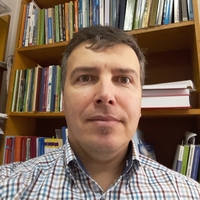Conferences by Clara María Ramos-Taboada

This EAA session will explore the concept of place and the spatial relationships between archaeol... more This EAA session will explore the concept of place and the spatial relationships between archaeological objects, material culture, domestic and ritual structures. It will consider the ways in which these relationships create processes that have a specific impact on the shaping and reshaping of communities and their identities. The processes of cultural and historical change from Antiquity to the High Middle Ages will be addressed. The aim is to examine how these processes marginalised and/or disregarded the material culture typical of specific groups/communities, while simultaneously transforming the cultural, political and social space, as well as the natural landscape of the affected areas. Due to the interdisciplinary nature of the approach, the following lines have been proposed: The formation of group identities as a result of the interconnectivity or clashing of various ethnic, religious and political communities. The analysis of new places, locations and sites of memory, whether the result of violent events in the past or of peaceful communication processes. The study of landscapes, urban and rural areas that have been (re)created as a result of new identities being assumed, whether forced or voluntary, in the context of acculturation and assimilation. https://submissions.e-a-a.org/eaa2025 Submission Organisers

This EAA session will explore the concept of place and the spatial relationships between archaeol... more This EAA session will explore the concept of place and the spatial relationships between archaeological objects, material culture, domestic and ritual structures. It will consider the ways in which these relationships create processes that have a specific impact on the shaping and reshaping of communities and their identities.
The processes of cultural and historical change from Antiquity to the High Middle Ages will be addressed. The aim is to examine how these processes marginalised and/or disregarded the material culture typical of specific groups/communities, while simultaneously transforming the cultural, political and social space, as well as the natural landscape of the affected areas. Due to the interdisciplinary nature of the approach, the following lines have been proposed:
The formation of group identities as a result of the interconnectivity or clashing of various ethnic, religious and political communities. The analysis of new places, locations and sites of memory, whether the result of violent events in the past or of peaceful communication processes. The study of landscapes, urban and rural areas that have been (re)created as a result of new identities being assumed, whether forced or voluntary, in the context of acculturation and assimilation.
Papers by Clara María Ramos-Taboada

PYRENAE, 2020
El objetivo de nuestro artículo es analizar la figura y el círculo familiar de Cornelia Faventina... more El objetivo de nuestro artículo es analizar la figura y el círculo familiar de Cornelia Faventina, mujer
atestiguada en la epigrafía de la Colonia Urbs Triumphalis Tarraco. Proponemos su estatus liberto
utilizando una serie de marcadores epigráficos y onomásticos combinados con el análisis de su comportamiento epigráfico, tanto como dedicante individual como a través de la comparación con el
de otras dos mujeres hispanas de contextos dispares. Su promoción social, constatable a través del
matrimonio con un duovir, la convierte en un caso excepcional dentro del patrón matrimonial propio
de los libertos en Roma y en la Hispania romana.
This publication aims to study the evidence concerning Cornelia Faventina, a woman attested in
the epigraphy of the Colonia Urbs Triumphalis Tarraco. We make use of new onomastic and epigraphic
markers which allow us to propose that she was a freedwoman. This conclusion will be reinforced by
comparing her epigraphic representation with two relevant cases of Hispanic women from different
backgrounds. Her social promotion, clearly attested by her marriage to a duovir, presents her as an
exceptional case in the freedpersons’ pattern of marriage in Rome and in Hispania.








Uploads
Conferences by Clara María Ramos-Taboada
The processes of cultural and historical change from Antiquity to the High Middle Ages will be addressed. The aim is to examine how these processes marginalised and/or disregarded the material culture typical of specific groups/communities, while simultaneously transforming the cultural, political and social space, as well as the natural landscape of the affected areas. Due to the interdisciplinary nature of the approach, the following lines have been proposed:
The formation of group identities as a result of the interconnectivity or clashing of various ethnic, religious and political communities. The analysis of new places, locations and sites of memory, whether the result of violent events in the past or of peaceful communication processes. The study of landscapes, urban and rural areas that have been (re)created as a result of new identities being assumed, whether forced or voluntary, in the context of acculturation and assimilation.
Papers by Clara María Ramos-Taboada
atestiguada en la epigrafía de la Colonia Urbs Triumphalis Tarraco. Proponemos su estatus liberto
utilizando una serie de marcadores epigráficos y onomásticos combinados con el análisis de su comportamiento epigráfico, tanto como dedicante individual como a través de la comparación con el
de otras dos mujeres hispanas de contextos dispares. Su promoción social, constatable a través del
matrimonio con un duovir, la convierte en un caso excepcional dentro del patrón matrimonial propio
de los libertos en Roma y en la Hispania romana.
This publication aims to study the evidence concerning Cornelia Faventina, a woman attested in
the epigraphy of the Colonia Urbs Triumphalis Tarraco. We make use of new onomastic and epigraphic
markers which allow us to propose that she was a freedwoman. This conclusion will be reinforced by
comparing her epigraphic representation with two relevant cases of Hispanic women from different
backgrounds. Her social promotion, clearly attested by her marriage to a duovir, presents her as an
exceptional case in the freedpersons’ pattern of marriage in Rome and in Hispania.
The processes of cultural and historical change from Antiquity to the High Middle Ages will be addressed. The aim is to examine how these processes marginalised and/or disregarded the material culture typical of specific groups/communities, while simultaneously transforming the cultural, political and social space, as well as the natural landscape of the affected areas. Due to the interdisciplinary nature of the approach, the following lines have been proposed:
The formation of group identities as a result of the interconnectivity or clashing of various ethnic, religious and political communities. The analysis of new places, locations and sites of memory, whether the result of violent events in the past or of peaceful communication processes. The study of landscapes, urban and rural areas that have been (re)created as a result of new identities being assumed, whether forced or voluntary, in the context of acculturation and assimilation.
atestiguada en la epigrafía de la Colonia Urbs Triumphalis Tarraco. Proponemos su estatus liberto
utilizando una serie de marcadores epigráficos y onomásticos combinados con el análisis de su comportamiento epigráfico, tanto como dedicante individual como a través de la comparación con el
de otras dos mujeres hispanas de contextos dispares. Su promoción social, constatable a través del
matrimonio con un duovir, la convierte en un caso excepcional dentro del patrón matrimonial propio
de los libertos en Roma y en la Hispania romana.
This publication aims to study the evidence concerning Cornelia Faventina, a woman attested in
the epigraphy of the Colonia Urbs Triumphalis Tarraco. We make use of new onomastic and epigraphic
markers which allow us to propose that she was a freedwoman. This conclusion will be reinforced by
comparing her epigraphic representation with two relevant cases of Hispanic women from different
backgrounds. Her social promotion, clearly attested by her marriage to a duovir, presents her as an
exceptional case in the freedpersons’ pattern of marriage in Rome and in Hispania.